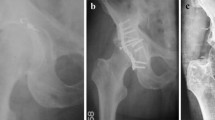Abstract
Introduction
The aim of this study was to evaluate functional outcome after surgically treated acetabular fracture using radiography and patient-reported outcome measures, and to determine predictors of hip joint failure 5 years post-surgery.
Patients and methods
All patients with acetabular fractures treated with open reduction and internal fixation (ORIF) at our unit are prospectively entered into a local register. 101 acetabular fractures in 112 patients treated from 2004 to 2007 were eligible for analysis 5 years after surgery. Radiographs and questionnaires regarding physical function (Short Form[SF]-36) and pelvic discomfort index (PDI, 100 % = worst outcome) were obtained. The primary outcome measure was “joint failure” defined as either secondary total hip arthroplasty (THA) or a Girdlestone situation. Univariable analysis was used to compare patients with joint failure to those without, and binary logistic regression analysis was performed to identify risk factors of joint failure.
Results
77 % of 101 followed patients had a preserved hip joint 5 years after surgery, and failure of the hip joint most often occurred within the first 2 years after injury. Patients with preserved hip joints had higher scores in the SF-36 physical function domain (median 75 vs. 48; p = 0.004) and better PDI (28 vs. 43 %, p = 0.03). Femoral head impaction was associated with an increased risk of joint failure [relative risk (RR) = 15.2, 95 % CI 3–95; p = 0.002], as was an age of ≥60 years at the time of injury (RR = 4.2, CI 1.3–15; p = 0.02).
Conclusions
Patients with failed hip joints after surgery for acetabular fracture have inferior global and disease-specific functional outcomes, even after secondary arthroplasty surgery. We suggest that patients with predictors of joint failure could benefit from other treatment strategies than ORIF, and primary insertion of THA may be an alternative treatment strategy for this subgroup.



Similar content being viewed by others
References
Giannoudis PV, Grotz MR, Papakostidis C, Dinopoulos H (2005) Operative treatment of displaced fractures of the acetabulum. A meta-analysis. J Bone Joint Surg Br 87:2–9
Tannast M, Najibi S, Matta JM (2012) Two to 20-year survivorship of the hip in 810 patients with operatively treated acetabular fractures. J Bone Joint Surg Am 94:1559–1567
Borg T, Berg P, Larsson S (2012) Quality of life after operative fixation of displaced acetabular fractures. J Orthop Trauma 26:445–450
Ware JE Jr, Sherbourne CD (1992) The MOS 36-item short-form health survey (SF-36). I. Conceptual framework and item selection. Med Care 30:473–483
Borg T, Carlsson M, Larsson S (2012) Questionnaire to assess treatment outcomes of acetabular fractures. J Orthop Surg (Hong Kong) 20:55–60
Letournel E (1980) Acetabulum fractures: classification and management. Clin Orthop Relat Res 151:81–106
Matta JM (1996) Fractures of the acetabulum: accuracy of reduction and clinical results in patients managed operatively within 3 weeks after the injury. J Bone Joint Surg Am 78:1632–1645
Development Core Team R (2012) R: A language and environment for statistical computing. R Foundation for Statistical Computing, Vienna
Liebergall M, Mosheiff R, Low J, Goldvirt M, Matan Y, Segal D (1999) Acetabular fractures. Clinical outcome of surgical treatment. Clin Orthop Relat Res 366:205–216
Mears DC, Velyvis JH, Chang CP (2003) Displaced acetabular fractures managed operatively: indicators of outcome. Clin Orthop Relat Res 407:173–186
Kreder HJ, Rozen N, Borkhoff CM, Laflamme YG, McKee MD, Schemitsch EH, Stephen DJ (2006) Determinants of functional outcome after simple and complex acetabular fractures involving the posterior wall. J Bone Joint Surg Br 88:776–782
Rolfson O, Karrholm J, Dahlberg LE, Garellick G (2011) Patient-reported outcomes in the Swedish Hip Arthroplasty Register: results of a nationwide prospective observational study. J Bone Joint Surg Br 93:867–875
Mears DC, Velyvis JH (2002) Acute total hip arthroplasty for selected displaced acetabular fractures: two to 12-year results. J Bone Joint Surg Am 84-A:1–9
Herscovici D Jr, Lindvall E, Bolhofner B, Scaduto JM (2010) The combined hip procedure: open reduction internal fixation combined with total hip arthroplasty for the management of acetabular fractures in the elderly. J Orthop Trauma 24:291–296
Ranawat A, Zelken J, Helfet D, Buly R (2009) Total hip arthroplasty for posttraumatic arthritis after acetabular fracture. J Arthroplasty 24:759–767
Author information
Authors and Affiliations
Corresponding author
Electronic supplementary material
Below is the link to the electronic supplementary material.
Rights and permissions
About this article
Cite this article
Borg, T., Hailer, N.P. Outcome 5 years after surgical treatment of acetabular fractures: a prospective clinical and radiographic follow-up of 101 patients. Arch Orthop Trauma Surg 135, 227–233 (2015). https://doi.org/10.1007/s00402-014-2137-y
Received:
Published:
Issue Date:
DOI: https://doi.org/10.1007/s00402-014-2137-y




